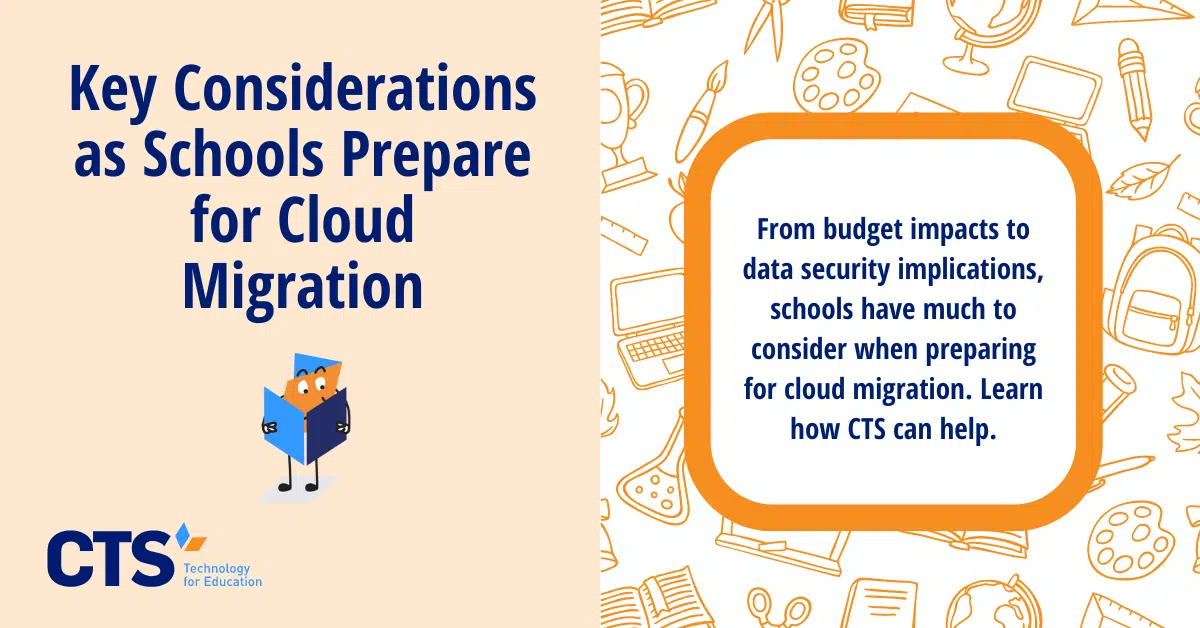For schools and districts still storing documents and emails locally, cloud migration is a topic of consideration.
Even before the Covid-19 pandemic, the topic of cloud migration was of great interest to educators. Cloud computing offers many benefits to schools and districts including easier access to email and documents, more collaboration between staff and students, and greater storage capacity. The rise of remote learning during the pandemic increased the need for cloud-based options. With staff logging in to their school’s network remotely every day, for schools not already on the cloud, the cumbersome nature of accessing email and documents via a virtual private network became even more apparent.
Even though the volume of remote learning is significantly lower than in the earlier days of the pandemic, certain aspects of remote learning are here to stay. The fabric of schooling and learning has been altered and this has accelerated cloud migration for schools that were still on the cusp of making that decision.
Even with staff and students back in the physical building, the increased flexibility and accessibility of cloud computing still has a noticeable and positive impact on teaching and learning. For the teacher who likes to finish lesson planning at home, the administrator who needs quick access to a school document over the weekend, or the students working collaboratively in class on a presentation, cloud apps make the technology simpler for the end-user so that they can focus on the actual work.
As schools prepare to migrate to the cloud, here are 3 questions to consider.
1. How will this cloud migration impact my budget?
Cloud computing offers the potential for significant savings for schools and districts. A key contributor to these savings is a reduction in the cost of on-premises infrastructure. Self-hosting a mail server – for example – requires spending on racks, cooling systems, and electricity. Of course, cloud migration comes with its own costs. Schools will need to pay for cloud storage; prices vary based on the provider. Some schools may also need to upgrade their WAN infrastructure to meet the needs or requirements of their cloud solution. Calculating the costs of the cloud migration and comparing them to the savings from a reduction in the use of on-premises hardware can help a school evaluate the impact of this shift on their overall budget.
2. How will this cloud migration impact my school’s security posture?
Data security will continue to be a priority for school leaders. Schools store a large amount of sensitive staff, student, and family data. The availability of this data plus the presence of relatively weaker security practices (as compared to corporations with massive budgets and large IT staff) has made schools a prime target for cybersecurity attacks. Cybercriminals are stealing school data, holding it for ransom, and/or selling it on the dark web. Any new additions to a school’s technology environment will have an impact on its security posture. The question is will that impact improve the security posture or will it weaken it?
When preparing for cloud migration, schools need to consider how they will ensure that their data is secured. A layered approach (involving security measures at the level of infrastructure, application, and user) creates a stronger security net. Schools can research the types of security measures that cloud providers offer — advanced encryption and authentification play a major role in infrastructure security. At the school level, enabling multi-factor authentication for applications and protecting user devices via identity protection and anti-virus solutions are considered best practices.
3. Which cloud solution will offer my school the most benefits?
Evaluating a cloud provider’s security measures is an important feature to consider. Customer support is another feature to learn about. What is the level and form of support that the cloud provider offers? If a school or district needs 24/7 support, does the provider offer that?
Does the vendor have experience working with schools? The cloud computing needs of a school or district are different from that of a business. Having a provider who understands the nuances and needs of schools increases the likelihood of a cloud solution being a good fit.
At CTS, we help schools plan and prepare for cloud migration.
Migrating to the cloud is an exciting prospect for schools because of the many benefits including more storage, lower costs, and increased flexibility. The decision to migrate to the cloud might be an easy “yes” for many schools, but considering what cloud features and characteristics to prioritize may take a bit longer. Deciding what to migrate to the cloud and what to continue to host locally might also take a bit longer, but there are only a certain number of hours in each day and school leaders have many other pressing topics demanding their attention. With the decision to work with CTS, schools gain a trusted partner. With our support, school leaders spend less time thinking about technology while simultaneously unlocking the full potential of their IT options.
Our team has worked with more than 60 schools across the United States supporting them to make the technology decisions that serve their school’s unique mission. Contact us today to learn more about our services and how we can help your school make a smooth transition to the cloud.




